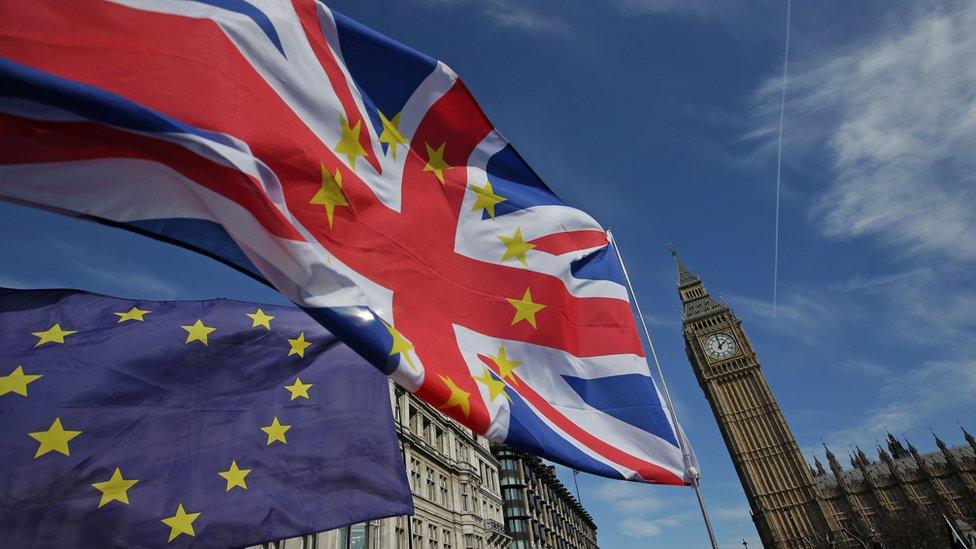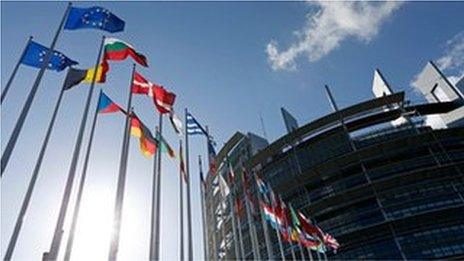2019 European elections opinion polls: How are the parties faring?
- Published
Opinion polls for the European Parliament elections on 23 May put the Brexit Party in the lead.


Each dot shows one poll result for one party. The trend lines are calculated as an average of the polls to date, with greater weight given to the most recent polls and to larger polls.
22 May: Final polls
Pollsters have been releasing their final figures ahead of voting on Thursday 23 May.
If anything the Brexit Party have extended the lead that they've held consistently over the last two weeks, although there is quite a lot of variation between the different polling companies. Unless the polls are seriously wrong they can expect to win the most seats when votes are counted on Sunday 26 May.
It's less easy to say who is in second place - largely because there is a huge range between estimates for Labour's share of the vote. YouGov has them on 13% whereas Panelbase has 25%.
So it's impossible to say whether they or the Lib Dems are on course to be runners up.
Most of the companies put the Conservatives in fourth, but not far ahead of the Greens. Change UK and UKIP are further behind.
It's important to restate that these are GB polls and the situation is very different in Scotland where the SNP are certainly expected to win. In Wales Plaid Cymru are challenging Labour for second place.
There will also be very significant variations between different regions of England. National polls cannot be a good guide to how results will go everywhere.
20 May: Weekend polls and regional breakdown
New polls over the weekend again continue a familiar trend. The Brexit Party has a clear lead across the country as a whole.
Most of the polling companies have Labour in second followed by the Liberal Democrats and Conservatives. But YouGov put Labour on a much lower share than the others - 15% in their two most recent polls - and have the Lib Dems ahead of them in second place.
Regional figures
The latest YouGov poll also provided a regional breakdown - this was possible because it had a large sample of more than 9,000 people.
It's only a single poll and it's important to keep in mind the point about other pollsters being more positive about Labour. But the breakdown fits the pattern you would expect - the Brexit Party is strongest in regions that voted firmly for Leave in the 2016 referendum, but weaker in areas where Remain was stronger.
So they lead in Wales and most of the regions of England - but not in Scotland, where the SNP are dominant, and not in London - where YouGov give a small lead to the Lib Dems.
17 May: Brexit Party and Lib Dems continue to rise
A new YouGov poll with a large sample of more than 7,000 people has the Brexit Party and Liberal Democrats making further advances at the expense of the Conservatives and Labour.
For the first time the Lib Dems are ahead of Labour in second place - and the Conservatives have fallen just below the Greens in fifth.
Of course this is just one poll but, as the chart suggests, it does fit with the direction of travel that's been clear over the last couple of weeks.
Wales
YouGov has also published a Welsh poll - the first since it was confirmed that the UK would take part in the Euro elections.
Like in Britain as a whole, it puts the Brexit Party in a clear lead, with 33% of the vote.
Labour and Plaid Cymru are battling it out for second place, on 18% and 16% respectively. And the Lib Dems, Greens and Conservatives trail further behind.
15 May: Further polls reinforce established pattern
Three new polls suggest that support for the various political parties has settled, for the time being, into a fairly clear pattern.
Across Britain as a whole, the Brexit Party leads the pack with Labour in second and the Conservatives and Liberal Democrats battling it out for third place.
In Scotland, there's no evidence to overturn previous polls which put the SNP in a dominant position.
Northern Ireland
There's also been a Lucid Talk poll this week for the election in Northern Ireland. That uses a different voting system from the rest of the UK - the Single Transferrable Vote, where voters get to rank candidates in preference order. Seats are awarded through a process of elimination and redistribution of votes.
Three seats are available. At recent elections they've gone to the DUP, Sinn Fein and the UUP.
But the poll suggests the race for the third seat is likely to be close this time.
Sinn Fein lead the poll in terms of first preferences with the DUP clearly ahead of the rest in second place. But it's very close for third between the SDLP, UUP and Alliance Party.
If the actual votes follow a similar pattern, the final outcome will depend upon how votes are redistributed after the weaker candidates are eliminated.
More on a 'proxy referendum'
It's not easy to interpret the results of the European elections as a proxy for another Brexit referendum - people might vote on other issues and it's hard to know what to do about Labour and the Conservative voters.
Academics at The UK in a Changing Europe have suggested an interesting alternative approach. In a report, external they suggest that it would be useful to look at levels of turnout in different parts of the country.
If turnout goes up most in areas that voted Remain in 2016, that could indicate that Remain voters would be more likely to turn up in any future referendum. Whereas if voting is stronger in Leave areas, it could suggest the opposite.
13 May: More pain for the Conservatives and Labour as Brexit Party and Lib Dems move forward
New polls over the weekend suggest the Brexit Party has further strengthened its position.
Opinium and YouGov now have them on 34% with a big lead over Labour in second place. However in a third poll, by ComRes, the picture looks much less clear - the Brexit Party are only narrowly ahead of Labour by 27% to 25%.
It's not just the Brexit Party who are on the up. The Lib Dems have also made progress - in the past three polls they've been in third place, ahead of the Conservative Party.
In fact, in YouGov's poll, the Tories are down in fifth place, below the Greens as well.
Proxy referendum?
One way that the results of the European elections will be analysed is as a sort of proxy vote for another referendum.
It will be interesting to add together the votes for anti-Brexit parties - SNP, Plaid Cymru, Lib Dems, Greens and Change UK - and compare the result with the combined score of UKIP and the Brexit Party.
By this measure, the polls suggest it's pretty close between these two groups, with the pro-Brexit group slightly ahead on average. However, it isn't necessarily a good guide as to how another referendum would go.
For one thing, people's reasons for voting will not just be about Brexit.
Another issue is that it doesn't account for Conservative and Labour voters. The two big parties might be near historic lows but they will still account for a decent proportion of voters.
Will those people be equally split between Leavers and Remainers?
It's possible to get a clue to this by looking at the detailed breakdown of the polling figures. This can be a risky business because the subsamples in polls aren't always representative so you can get misleading results.
However, in this case the pattern is very consistent. People who say they will vote Conservative are evenly split between Remain and Leave. But people who say they'll vote Labour favour Remain by about 3:1.
10 May: Brexit Party makes a big impact
The polls that have been published up to now can fairly neatly be divided into two groups: before and after the Brexit Party's campaign launch on 12 April.
Before then, Nigel Farage's new group and UKIP seemed to be splitting the pro-Brexit vote pretty evenly - allowing Labour to enjoy a clear lead overall.
Afterwards, the Brexit Party has risen to the top of the pile, mostly at the expense of UKIP. There have only been two polls since with another party (Labour) in the lead.
As with all polls, it's important to remember that they are subject to error. And that can be particularly true when there are new parties in the frame.
Historic Conservative low?
Prospects for the Conservatives look bleak, according to the polls so far. They've been bumping around in the low to-mid teens. That would be by a distance the lowest share of the vote ever for the party in a national election.
Labour are faring better, although considerably below where they would want to be. A score in the mid-20s would mean little change since 2014 when they were runners-up to UKIP.
Anti-Brexit parties
The creation of Change UK - The Independent Group, adds to an already crowded field for pro-EU, anti-Brexit parties.
They are fighting for votes with the Liberal Democrats, Greens, SNP and Plaid Cymru.
In Scotland, the SNP are on course to dominate. But in other parts of the UK, the divisions could be costly.
European elections in Britain use a form of proportional representation, but on a regional basis. Most of the regions have too few seats to guarantee a fully proportional outcome.
It's quite easy for a party to get a decent number of votes in a region but fail to win a seat. In 2014, for example, 160,000 votes (10.7%) was not enough for the Liberal Democrats in the South West.
If the final result this time is close to what the polls have been suggesting, the anti-Brexit parties could end up missing out in several regions.
However, in the latest to be published, it perhaps looks as though in England the Lib Dems are emerging as the strongest of them - possibly receiving a boost after their very strong showing in the local elections.
NB: Most polls focus on vote share in Great Britain and exclude Northern Ireland.
- Published8 May 2019

- Published5 December 2019

- Published15 May 2019
